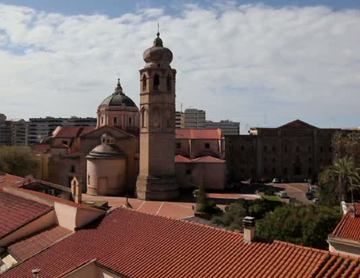The Byzantine term “condaghe” defines the act by which a donation was constituted in favor of an ecclesiastical body. In practice, it has come to designate the code in which the complex of parchment documents relating to the acquisition and administration of assets by a monastery was transcribed.
Of these documents, drawn up in diocesan or monastic “scriptoria”, those of Saint Peter of Silki, Saint Nicholas of Trullas, Saint Mary of Bonarcado and Saint Michael of Salvenor have come down to us.
The “Condaghe di Santa Maria di Bonarcado”, preserved in the Cagliari University Library with the identifier 277, is composed of a series of manuscript files compiled between the beginning of the 12th and the middle of the 13th century, and reports the heritage movements of the monastery of the same name.
The toponym Bonarcado, in its variants “Bonarcatu, Bonarcato, Bonarcanto” handed down from the condaghe, derives from the Greek Panakhrantos “immaculate, very pure”, the attribute of the Virgin Mary venerated in a sanctuary in the place that was a Greek monastic seat passed later on by the Camaldolese.
The Benedictines' settlement in this town dates back approximately to 1110, a date recorded on the oldest map of the Condaghe, from which it appears that the Arborense judge Constantine I of Lacon-Serra, with his wife Anna de Zori and with the consent of the archbishop of Oristano, established a monastery in honor of the Trinity and the Virgin, entrusting it to the Camaldolese abbot of San Zeno of Pisa, on the condition that he send his own monks there, to maintain the monastery, to work, to build themselves and they dedicated themselves to the care of the fields. Nine churches and assets of various kinds were linked to the foundation.
The consecration of the Camaldolese church dates back to the year 1146/47, a probable date for two condaghe scrolls, from which it appears that the Arborense judge Barisone I de Lacon-Serra increased the monastery's possessions with the donation of other assets, on the occasion of the solemn ceremony of consecration of the “new church” of Santa Maria, which took place in the presence of the Arborense archbishop Comita de Lacon. In addition to the population and representatives of the Arborense curators, the archbishop of Pisa Villano (as papal legacy) and the other three judges of Sardinia attended the ceremony: Constantino-Salusio III of Cagliari, Gonnario di Torres, Constantine III of Gallura.
The dedication to Santa Maria and the appellation of “new church” derive from the pre-existence of an older cult building, still present and known as the “sanctuary” of Our Lady of Bonacattu, whose very small capacity justifies the need for a new and more representative building.
Despite the direct dependence of the monastery on Pisa, the Romanesque factory of the church of Santa Maria di Bonarcado reveals Tuscan methods not tied to Pisan forms, but reworked during the planting phase with extreme precision of cutting and installation of the ashlars.
Update
Video
Year : 1995

Author : Spadetta Giulio
Results 2 of 45041
View All
Comments